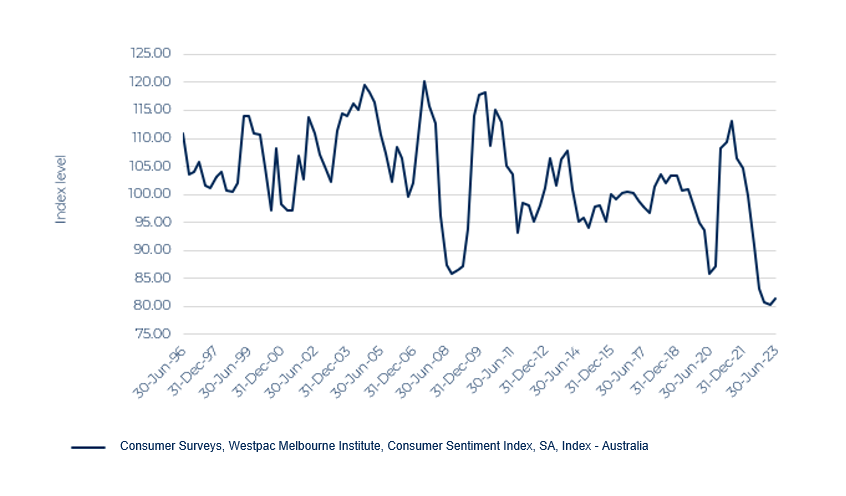In the June 2023 Perpetual Private Quarterly Market Update we look at the forces replacing the pandemic and interest rates as key market movers. You can download our full report – or read our concise review below.
Please note: except where otherwise noted or quoted, the views in this article are those of Perpetual Private’s investment team.
June Quarter 2023: What happened?
- Despite sticky inflation, more rate rises and an attritional war in Ukraine, sharemarket investors celebrated in June. Global shares were up nearly 7% for the quarter and 20% for the 2023 financial year.
- The local market had a quiet quarter, rising less than 1%. However, over the past year Australian shares handed investors a 14% return.
- Technology stocks rebounded, with the NASDAQ up 13% for the quarter and over 30% for the year. Enthusiasm for the productivity potential of AI fuelled the tech revival.
- Bond markets were weak with global bonds down 0.30% for the quarter and around 1% for the year. Local fixed income was down nearly 3% for the quarter and up just over 1% for the year.
(Indices referenced: MSCI AC World, S&P/ASX 300, Bloomberg Global Aggregate index, Bloomberg AusBond Composite (0+Y) index. All performance numbers to end June 2023 quarter unless otherwise stated).
“The consumer is always right” Harry Gordon Selfridge
Since the start of 2020, the investment landscape has been painted by big themes: Covid lockdowns, Ukraine, inflation and rising interest rates. Halfway through 2023 that picture is sharpening. The outlook for markets may now depend on decisions in Main Street, not Martin Place.
Until relatively recently, consumers had ignored the ladder-climb of interest rates around the globe and kept spending. That’s had a range of results:
- It’s supported corporate profits and share prices – they’re up 19% around the globe and 14% in Australia in the past year.
- It’s underpinned bountiful job numbers. Reserve Bank Deputy Governor, Michelle Bullock, says, “The share of the Australian population in employment has never been higher.”[1]
- It’s forced Philip Lowe and his global counterparts to keep raising rates. In Australia they’re up a full 4% since last May.
When the going gets tough, the tough keep shopping
What’s behind this consumer resilience? Part of it is human nature. After two years where purses were pursed and wallets wedged closed, consumers went shopping for flights and flew into shopping centres.
Much of it is taxpayer funds. Governments effectively bribed people to stay locked down and with nowhere to spend that money, consumers entered the rate tightening cycle laden with cash.
According to Perpetual Private Investment Director, Andrew Garrett, US consumers are believed to have $US500 billion in excess savings. That’s a big number. But it’s down 80% in the past 18 months. “As those stimulus savings burn down, we’re watching the consumer carefully,” says Andrew.
|
Figure 1. Consumer health – Consumer sentiment |

Freefalling
In Australia that slowdown is clear in the chart above, taken from the Reserve Bank’s June Chart Pack. Market research house Roy Morgan says 39% of Australians expect to be ‘worse off’ this time next year. That’s the highest figure for that pessimism indicator since late 1989[2].
The local shopper is not just dealing with a much bigger mortgage bill. The Australia Energy Regulator says ‘residential customers on standard retail plans’ could face energy bills up over 20% from 1 July[3]. And whilst minimum wages have risen, most workers’ pay packets are fruitlessly chasing inflation.
“In large, modern economies like the US and Australia, consumer spending is a major element of economic activity,” says Andrew Garrett. “So falling consumer sentiment shows up in weaker corporate balance sheets, emptier government coffers and, eventually, stock market performance.”
Artificial intelligence and new nuances
Of course, consumer sentiment is not the only force that will move markets for the rest of 2023 and beyond. The revolution in Artificial Intelligence symbolised by ChatGPT (the most rapidly adopted consumer app in history) could reshape productivity and unleash new avenues for economic growth.
Playing new drivers
Over the next twelve months the forces driving markets are going to multiply. The interest rate environment will still be crucial. But so will geopolitics, consumer sentiment and technological change. Thanks to elevated rates and the struggle to get staff back to their desks, weakness in global office property markets – and the downstream effect on lenders - might become a swing factor. So how do portfolio managers deal with these variegated challenges?
“One of the advantages we have is our use of specialist fund managers,” says Andrew Garrett. “They’re close to the action, close to the facts as they evolve. And that means we’re making investment decisions that are information rich.”
Perpetual’s investment methodology combines those bottom-up insights with the risk-management benefits of diversification and strategic portfolio construction. The argument for that approach was best put by its architect, Nobel Prize winner, Harry Markovitz, who died in June.
“A good portfolio is more than a long list of good stocks and bonds” said Markovitz. “It is a balanced whole, providing the investor with protections and opportunities with respect to a wide range of contingencies.”
Perpetual Private’s Quarterly Investment Update for June 2023 covers the changing nature of investment dynamics and looks at the outlook for shares, fixed income, real estate, currency and alternatives.
[1] Achieving Full Employment, Speech to the Ai Group, 20 June 2023
[2] https://www.roymorgan.com/findings/9245-anz-roy-morgan-consumer-confidence-june-6
[3] AER releases final determination for 2023–24 Default Market Offer, Australian Energy Regulator, Press Release, 25 May, 2023